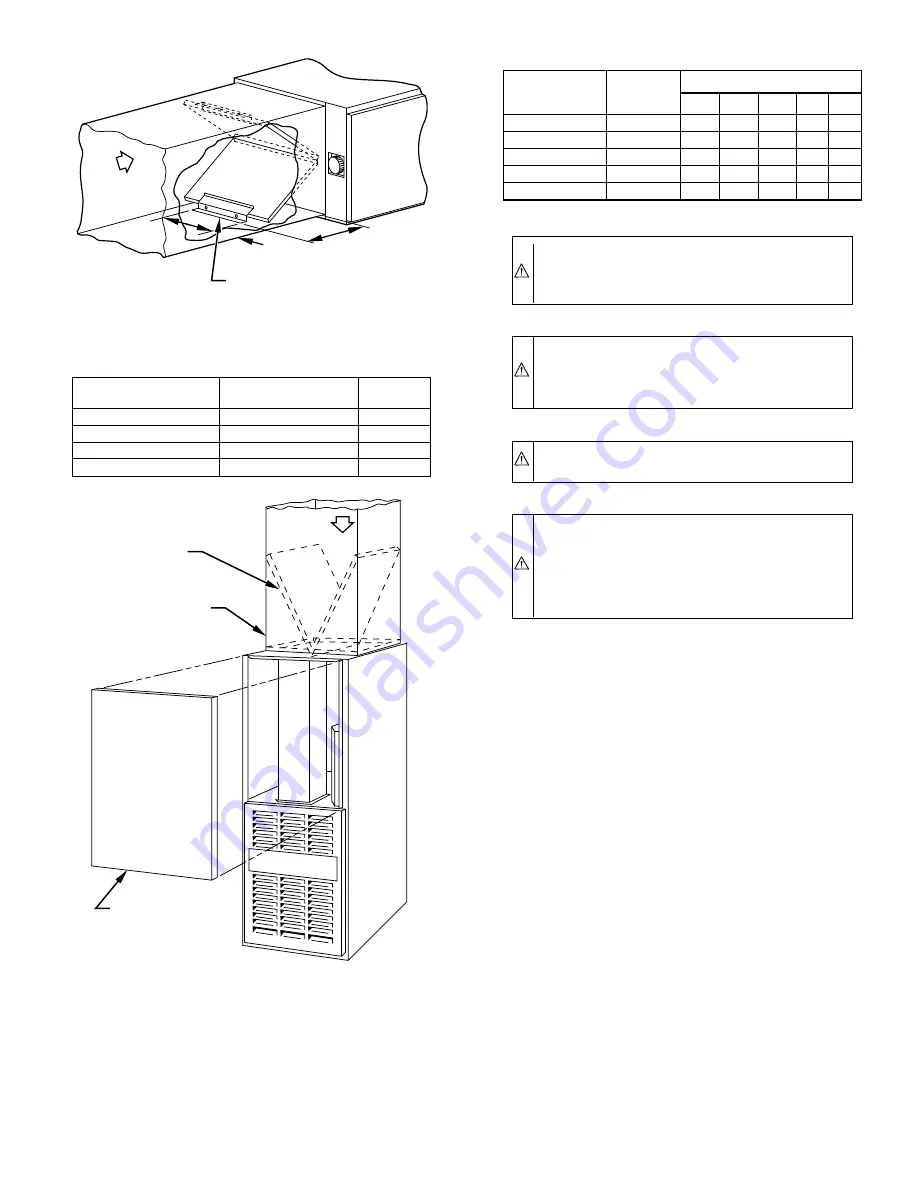
VII.
GAS PIPING
Gas piping must be installed in accordance with national and local
codes. Refer to the current edition of the NFGC.
Canadian installations must be installed in accordance with NSC-
NGPIC and all authorities having jurisdiction.
Refer to Table 5 for recommended gas pipe sizing. Risers should
be used to connect to the furnace and to the meter.
CAUTION:
If a flexible connector is required or al-
lowed by the authority having jurisdiction, black iron
pipe shall be installed at the gas valve and extend a
minimum of 2 in. outside the furnace casing.
WARNING:
Use the proper length of pipes to avoid
stress on the gas control manifold. Failure to follow this
warning could result in a gas leak, causing fire, explosion,
personal injury, or death.
CAUTION:
Connect the gas pipe to the furnace using a
backup wrench to avoid damaging gas controls.
WARNING:
Never purge a line into a combustion
chamber. Never use matches, candles, flame, or other
sources of ignition to check for gas leakage. Use a
soap-and-water solution to check for gas leaks. Failure to
follow this warning could result in fire, explosion, per-
sonal injury, or death.
Joint compounds (pipe dope) should be applied sparingly and only
to the male threads of the joints. This pipe dope must be resistant
to the action of propane gas.
Install an accessible manual shut-off valve upstream of the furnace
gas controls and within 72 in. of the furnace. A 1/8-in. NPT
plugged tapping, accessible for test gage connection, must be
installed immediately upstream of the gas supply connection to the
furnace and downstream of the manual shut-off valve. Place a
ground joint union between the gas control manifold and the
manual shut-off.
Install a sediment trap in the riser leading to the furnace. The trap
can be installed by connecting a tee to the riser leading from the
furnace. Connect a capped nipple into the lower end of the tee. The
capped nipple should extend below the level of the gas controls.
(See Fig. 10.)
Piping should be pressure tested in accordance with local and
national plumbing and gas codes before the furnace has been
attached. If the pressure exceeds 0.5 psig (14-in. wc), the gas
supply pipe must be disconnected from the furnace and capped
before the pressure test. If the test pressure is equal to or less than
0.5 psig (14-in. wc), close the manual shut-off valve located on the
gas valve before the test. It is recommended that the ground joint
union be loosened before pressure testing.
After all connections have been made, purge the lines and check
for gas leakage with regulated gas supply pressure.
VIII.
ELECTRICAL CONNECTIONS
A.
115-v Wiring
Refer to the unit rating plate or Table 6 for equipment electrical
requirements. The control system requires an earth ground for
proper operation.
TABLE 4—FILTER RETAINER (IN.)
FURNACE CASING
WIDTH
FILTER SIZE AND
QUANTITY
D
14-3/16
(2) 14 X 20 X 1
14-3/8
17-1/2
(2) 14 X 20 X 1
13-3/8
21
(2) 16 X 20 X 1
11-5/8
24-1/2
(2) 16 X 20 X 1
10-1/4
Fig. 8—Horizontal Filter Arrangement
A82173
FIELD-SUPPLIED
FILTER RETAINERS
AIRFLOW
D
12
″
4
″
Fig. 9—Downflow Filter Arrangement
A88486
RETURN-AIR
PLENUM
AIRFLOW
ACCESS DOOR
INSTALLATION
POSITION
OF FILTERS
TABLE 5—MAXIMUM CAPACITY OF PIPE *
NOMINAL IRON
PIPE SIZE
(IN.)
INTERNAL
DIAMETER
(IN.)
LENGTH OF PIPE (FT)
10
20
30
40
50
1/2
0.622
175
120
97
82
73
3/4
0.824
360
250
200
170
151
1
1.049
680
465
375
320
285
1-1/4
1.380
1400
950
770
660
580
1-1/2
1.610
2100
1460
1180
990
900
* Cubic ft of gas per hr for gas pressures of 0.5 psig (14-in. wc) or less, and a
pressure drop of 0.5-in. wc (based on a 0.60 specific gravity gas). Ref: Table
10-2 NFPA 54/ANSI Z223.1-1992.
—7—


































